
We are proud to be Texans. This page is for those persons who would like to know more about our state and its history. If you have no interest in the historical aspects of Texas, then this page is not for you, but we do thank you for dropping by.
Never ask a man where he's from! If he's from Texas, you won't have to ask, he'll tell you! And if he isn't from Texas, you shouldn't embarrass him by calling attention to it!" (grin)








Displayed below, you will find a field of bluebonnets, our state flower, and Texas longhorn cattle which are identified with Texas the world over.
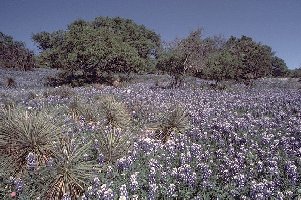

Texas is a huge state, stretching 773 miles from east to west, and 801 miles from north to south. It takes up almost 7.5% of the total land area of the United States. Texas is as large as all of New England, New York, Pennsylvania, Ohio, and Illinois combined. We are the second most populous state, after California. The name Texas comes from the Spanish and Indian words, tejas and techas, "friends or allies."
In 1820, Moses and Stephen F. Austin, started the colonization that culminated in the establishment of a provisional government on November 3, 1835, and independence from Mexico on March 2, 1836. After ten years as an independent Republic, Texas became a state on December 29,1845.
The modern economic development of Texas started in January 1901 with the eruption of an oil well drilled at Spindletop, near Beaumont. The rapid discovery of oil in other parts of the state led to a boom that has never really stopped. The economy of Texas has become highly diversified, and its population has more than quintupled during the 20th century.
The state has 3,700 streams with a combined length of 80,000 miles. The major rivers are the Rio Grande (separates Texas and Mexico), the Red River (separates Texas from Oklahoma), the Colorado River (longest in the state), and the Sabine River which forms the southern half of the boundry between Texas and Louisiana. Of course, we also have the Pecos River, the Devils River, the Nueces River, the Guadalupe River, and the Brazos, which was the medium used by Stephen F. Austin in bringing in the first 300 settlers. There are many man made lakes around the state, the largest being Lake Texhoma (partly in Oklahoma) which is one of the largest inland lakes in the U.S, and course, we have the Gulf of Mexico.
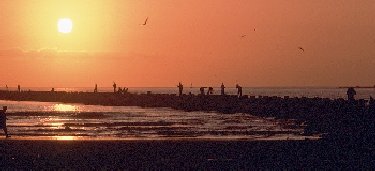
The climates of Texas range from the hot subhumid found in the Rio Grande valley to the cold semiarid of the northern part of the Panhandle, and from the warm humid in the east to the arid of the Trans-Pecos. Rainfall varies from 1,400 mm (55 in) in the east to less than 250 mm (10 in) in the west. The average number of days with some precipitation ranges from 44 in El Paso to 110 in Houston. Drought can be a serious problem, especially in the Great High Plains, where an average of seven droughts occur in a ten-year period. Temperatures, too, vary greatly, ranging from 49 degrees C (120 degrees F) to -31 degrees C (-23 degrees F). Each year about 100 tornadoes occur, most frequently in the Red River valley.
The dense pine forests of eastern Texas contrast with the deserts of the western part of the state, and the grassy plains of the north contrast with the semiarid brushes of southern Texas. The Rio Grande valley is mostly covered by brush, mesquite, cedar, post oak, and in places a dense growth of prickly pear. In the southwest are found cactus, agave, and yucca.
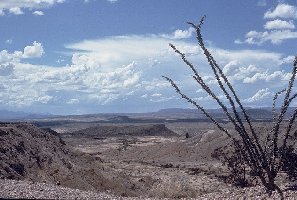
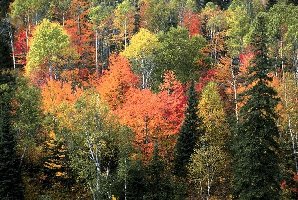
Texas's two extensive metropolitan areas are the Dallas-Fort Worth and the Houston-Galveston-Brazoria consolidated metropolitan statistical areas. Together they constitute about 45% of the state's population. In addition there are 23 metropolitan statistical areas (mainly single-city metropolitan regions) that together with the consolidated areas account for more than 80% of the population. Racially, Texas is made up of whites, who constitute about 75% of the population; blacks, about 12%; and other nonwhites, about 13%.
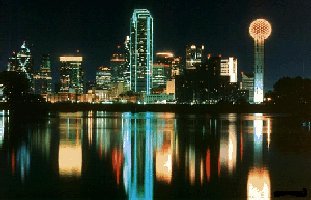

Texas attracts millions of out-of-state visitors annually; its tourist-related businesses compete with those of California and Florida for the U.S. travel market. Many visitors explore Dallas, San Antonio, Houston, Fort Worth, El Paso, Austin, and other cities. Sites of special interest range from Nacogdoches in East Texas, one of the state's oldest cities, to the Lyndon B. Johnson Space Center near Houston. Texas's two national parks, Big Bend National Park and Guadalupe Mountains, are also popular, as are the numerous and varied state recreation areas. Hunting and fishing are popular pastimes for visitors and Texans alike, as are professional and college sports events. Would you like to see these sunsets in person? Come to Texas and visit.


After the sale of Louisiana to the United States, Augustus Magee, a U.S. Army officer, along with Bernardo Gutierrez, a Mexican patriot, led an expedition into Texas in 1812-1813 and captured Nacogdoches, Goliad, and San Antonio.
In 1821 the white population of Texas was 7,000, with Goliad, San Antonio, and Nacogdoches the only towns of any size. During this period Mexico secured its independence from Spain, and, in 1823, Stephen Austin went to Mexico City to seek confirmation of his father's grant. A new law required that agents introduce at least 200 families of colonists, so Austin made an agreement with the Mexican governor to settle 300 American families. Colonization was so successful, however, that by 1836 the population of Texas was 50,000.
War broke out between the American settlers and the Mexican government in 1835, and the Texans won the first battle at Gonzales on Oct. 2, 1835. The same year the Texans captured San Antonio after a devastating siege; a provisional government was set up on Mar. 2, 1836, and Sam Houston was named commander in chief of the Texas armies, Stephen Austin having gone to Washington to solicit aid.
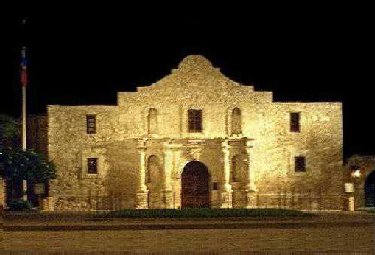
In February and March 1836 one of the most heroic battles in history occurred at the Alamo. The besieged Texas forces commanded by William B. Travis had been reduced to 157. He appealed for help, and about 30 additional men from Gonzales broke through the lines of the Mexican general, Antonio Santa Anna. The 187 defenders, commanded by Travis, James Bowie, and Davy Crockett, then held the Alamo for another five days before it fell. March also saw a massacre at Goliad, in which the outnumbered Texans, having surrendered after a battle on Coleto Creek, returned to Goliad only to be killed on the orders of Santa Anna.
Despite reverses, the Texans declared their independence in a great spirit of resistance, and on Mar. 2, 1836, David Burnet was named provisional president. Thinking the war was over, Santa Anna moved eastward with his army. Sam Houston's troops--half the number of the Mexicans--occupied a position at the junction of the San Jacinto River and Buffalo Bayou, opposite Santa Anna's camp. On the afternoon of April 21 the Texans attacked while Santa Anna was having his siesta. Their battle cry was "Remember the Alamo; Remember Goliad." Santa Anna fled but was taken the next day and held prisoner for six months (see Texas Revolution).
The Texas republic, whose independence had been recognized by the United States, Great Britain, France, Holland, and Belgium, was soon struggling with Indian wars, raids by Mexican forces, and financial problems.
In September 1836, Texans voted for annexation by the United States; approval by the U.S. Congress was delayed until 1845, however, because of the northern states' opposition to the extension of slavery. On Dec. 29, 1845, the U.S. Congress accepted the Texas state constitution, and Texas became the 28th state, with legal slavery.
The Mexican War between the United States and Mexico followed within a few months of Texas' entry into the union. The U.S. victory in that war established the Rio Grande as the border between Mexico and the United States. Texas, however, claimed all the territory from the mouth of the Rio Grande to its source in southern Colorado, a claim vigorously opposed by those who wished to exclude slavery from the territories newly acquired from Mexico. In 1850, as part of the Compromise of 1850, Texas relinquished its claim to half of what today is New Mexico and portions of Colorado, Wyoming, Oklahoma, and Kansas in exchange for \\$10 million.
Texas withdrew from the Union on Feb. 1, 1861. Little fighting took place on Texas soil during the Civil War, the most important engagements being the capture and recapture of Galveston, the principal port. A battle took place at Palmito Ranch near Brownsville, after General Lee had already surrendered at Appomattox.
Military rule following the Civil War was short-lived, but the state was inundated with carpetbaggers. On Mar. 30, 1870, Texas was readmitted to the Union after ratifying the 13th, 14th, and 15th amendments to the U.S. Constitution. Following the Civil War cattle ranching became increasingly important to the economy, and vast herds were driven to the railroad in Kansas over the Chisholm Trail.
Of necessity, this was a capsuled version of Texas history but, hopefully, one that will give you some idea of the history of our state. Thanks for stopping in to visit.




